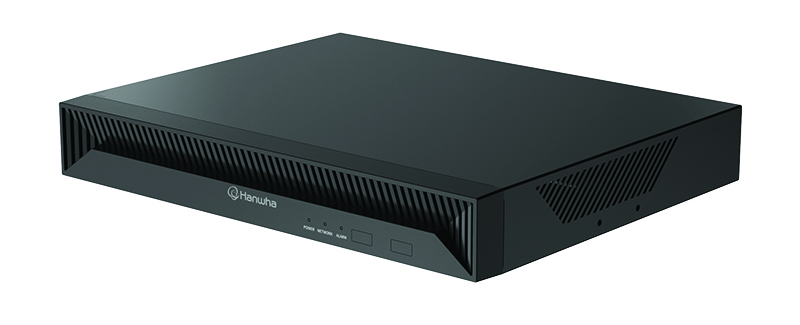
The AIB-800 box is promoted as being able to upgrade an existing IP based CCTV system to provide AI based detection features without system changes or additional monthly recurring expenses. The box allows up to 8 channels from the Wisenet range or compatible ONVIF cameras to be given enhanced detection capabilities including people and vehicle detection and counting.
The case has dimensions of approximately 300 x 241 x 48 mm and a weight of 1.4kg.
Getting started
The AIB-800 has an external PSU providing 12 volts at up to 48 watts via a rear mounted 4-pole connector. The supplied mains lead uses a European CEE 7/7 type plug to C15 (kettle style) connector so the plug must be changed or an alternative lead used.
In addition to the power input, the rear panel has an RJ45 network connection socket, a USB debug connection, a multi-pole alarm connector and finally a mini-jack console socket.
The alarm connector block consists of 2 x 10-way blocks with the top section for alarm input and an alarm reset function. The lower block provides contacts for four changeover relay outputs and a ground terminal.
Additionally, there is a small aperture leading to an internal switch that is assumed to provide a factory reset function.
Once powered the IP address of the device can be located using standard network search tools or using the Hanwha Wisenet Device Manager software. Chrome, Edge, and Safari are given as supported browsers.
Operation
On first connection or after a factory reset, you are requested to enter a password of at least 8 characters for the AIBox. Once entered you are taken to the Live view page from where you can select the Setup icon to search for network connected cameras.
The first option is to enter cameras using the Channel setup page, this can be using the auto detect button or by manual entry. Wisenet cameras will include preview images but not ONVIF cameras.
In practice it was found that only certain ONVIF conformant cameras were identified by the system even from the same manufacturers. Manual connection attempts resulted in an “Auth failed” message. Unfortunately, the available documentation does not give any diagnostic pointers and has limited configuration examples.
Read the full review in the April 2025 edition of PSi magazine

